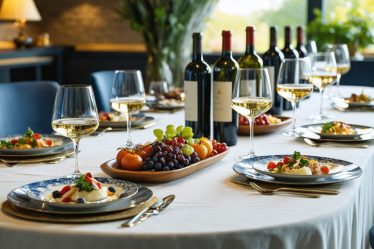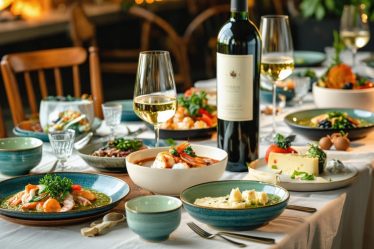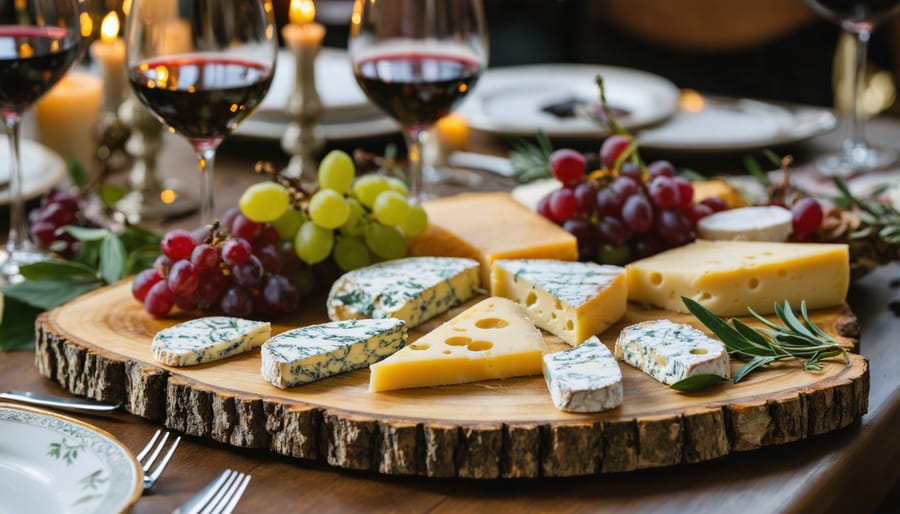
Transform your next gathering into an unforgettable wine tasting experience at home by mastering the art of cheese and wine pairing. Picture this: the gentle clink of glasses, the excited murmur of friends discovering new flavor combinations, and you, confidently guiding them through a curated tasting journey that rivals any high-end wine bar.
Whether you’re a budding sommelier or simply love entertaining, hosting a cheese and wine pairing class creates those magical moments where conversation flows as freely as the wine. From creamy Brie paired with crisp Champagne to aged Gouda complementing bold Cabernet Sauvignon, these tastings unlock a world of sensory discoveries that transform casual get-togethers into sophisticated soirées.
In this guide, we’ll walk through everything you need to know about organizing your own cheese and wine pairing class – from selecting the perfect combinations to creating an atmosphere that encourages learning and laughter. Get ready to elevate your hosting game and create an experience your guests won’t soon forget.
Setting Up Your First Cheese and Wine Pairing Class
Creating the Perfect Ambiance
Creating the perfect atmosphere for your cheese and wine pairing class is just as important as the selections themselves. Think of your space as a canvas where fine dining etiquette meets casual comfort. Start with lighting – dim overhead lights and add strategic candles or warm accent lamps to create a cozy, intimate feel that still allows guests to see their pairings clearly.
Temperature plays a crucial role in both wine service and cheese enjoyment. Keep your room between 68-72°F (20-22°C) for optimal tasting conditions. Set up your space with dedicated areas for different wine and cheese stations, ensuring easy flow and conversation between guests.
Background music should enhance, not overwhelm – think soft jazz or classical pieces at a volume that allows comfortable conversation. I’ve found that instrumental versions of familiar songs work wonderfully, creating an elevated yet approachable atmosphere.
Consider setting your tasting table with crisp white linens and simple centerpieces that won’t compete with the aromas of your carefully selected wines and cheeses. Fresh flowers add a lovely touch, but avoid strongly scented blooms that might interfere with the tasting experience.
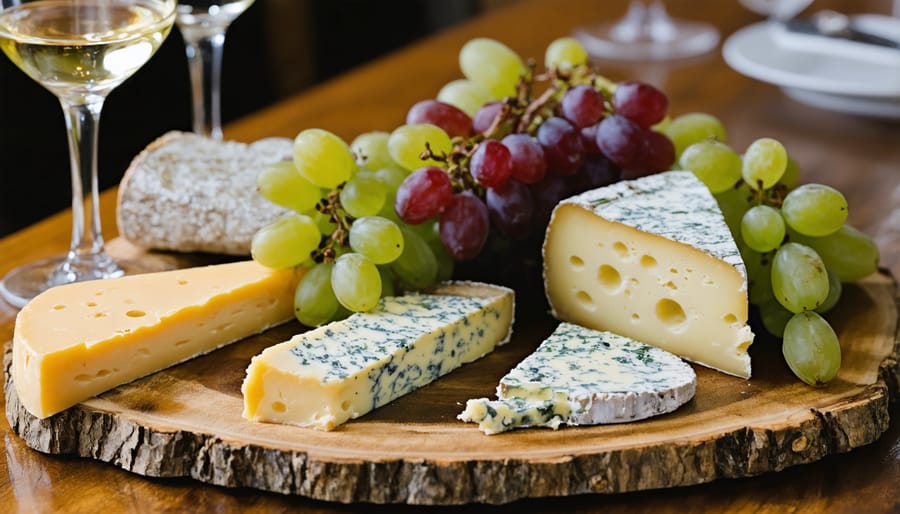
Essential Equipment and Supplies
To host a successful cheese and wine pairing class, you’ll need these essential items to create the perfect tasting experience. Start with quality serving boards – I recommend having at least two large wooden or slate cheese boards for attractive presentation. Don’t forget small plates and wine glasses for each guest (plan for at least two glasses per person to compare different wines).
For cheese service, you’ll need cheese knives of varying styles: a flat blade for soft cheeses, a sharp knife for hard cheeses, and a spreader for creamy varieties. Small cheese markers or labels help guests identify each selection.
Essential supplies include:
– Wine bottle openers and stoppers
– Spittoons or dump buckets
– Water pitchers and glasses
– Plain crackers or bread as palate cleansers
– Small bowls for accompaniments like nuts, dried fruits, and honey
– Paper and pens for tasting notes
– Napkins and cleaning supplies
– Temperature gauge for serving wines properly
– Ice bucket and ice
– Cheese storage containers
Pro tip: Keep some palate-cleansing items like plain water crackers, apple slices, or bread readily available between tastings to help guests experience each pairing with fresh taste buds.
The Perfect Cheese Selection
Must-Have Cheese Categories
When planning your cheese and wine pairing adventure, you’ll want to include a diverse selection that covers all the major cheese categories. Trust me, this variety will make your tasting experience so much more interesting and educational!
Start with fresh cheeses like creamy goat cheese or buffalo mozzarella – these delicate options are perfect for introducing your palate to the tasting journey. Next, include some soft-ripened cheeses such as Brie or Camembert, which offer that luxurious, buttery texture everyone loves.
Semi-soft cheeses like Havarti and Fontina bring a wonderful middle ground to your selection. They’re approachable yet complex enough to keep things interesting. Don’t forget about aged hard cheeses – Aged Cheddar, Parmigiano-Reggiano, or Manchego provide those delightful crystalline textures and robust flavors that wine loves.
Blue cheeses are essential too! Whether you choose a milder Gorgonzola Dolce or a bold Roquefort, these distinctive cheeses create memorable pairing moments. I always like to include at least one washed-rind cheese (like Epoisses or Taleggio) for those guests who enjoy more adventurous flavors.
Remember to serve your cheeses at room temperature – this allows their full flavor profiles to shine through. I usually take them out of the refrigerator about an hour before guests arrive. This simple step makes such a difference in the tasting experience!
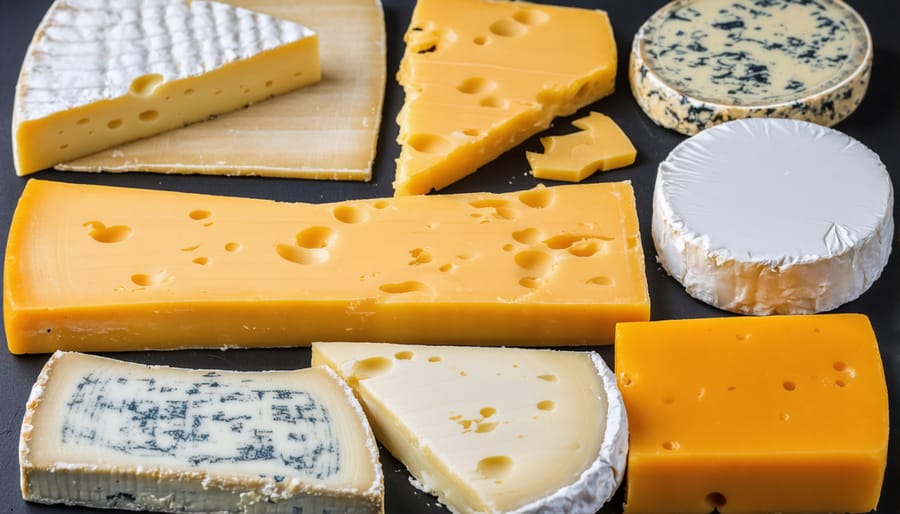
Proper Serving Temperatures and Portions
Let me share a game-changing tip I learned during my first cheese class: temperature matters more than you might think! Cheese should be served at room temperature (around 68-72°F) to fully experience its flavors and textures. I always take my cheeses out of the refrigerator about an hour before guests arrive – trust me, it makes a world of difference!
For portions, think about 1-2 ounces of each cheese per person. When I’m hosting, I usually plan for about 4-5 different cheeses total, which means around 6-8 ounces of cheese per guest. This might sound like a lot, but remember – we’re creating an experience here!
As for wine serving temperatures, whites should be chilled to about 45-50°F (take them out of the fridge 15 minutes before serving), while reds are best at a cool room temperature of 60-65°F. Pro tip: I like to pour about 2 ounces of wine per tasting – this gives everyone enough to savor each pairing without overwhelming their palate.
To keep track of temperatures without looking too fussy, I use this simple rule of thumb: if the cheese feels slightly soft to the touch and the red wine bottle feels cool (not cold) in your hand, you’re probably in the right range. Remember, these guidelines are just starting points – the most important thing is enjoying the experience with friends!
Selecting Complementary Wines
Classic Wine and Cheese Combinations
Let’s explore some timeless wine and cheese pairings that never disappoint! As you delve deeper into wine and food pairing principles, these classic combinations will serve as your foundation for more adventurous matchmaking.
Start with the beloved pairing of aged cheddar and Cabernet Sauvignon. The sharp, nutty notes of the cheese perfectly complement the wine’s bold tannins and dark fruit flavors. For something lighter, try fresh goat cheese with Sauvignon Blanc – the wine’s citrusy brightness matches the cheese’s tangy character beautifully.
Brie and Chardonnay create magic together, with the wine’s buttery notes enhancing the cheese’s creamy texture. For blue cheese lovers, nothing beats a glass of Port – the wine’s sweetness balances the cheese’s salty intensity in the most delightful way.
One of my personal favorites is pairing Gruyère with Pinot Noir. The cheese’s subtle nuttiness and the wine’s earthy notes create an absolutely dreamy combination that never fails to impress my guests. For an Italian-inspired duet, try Parmigiano-Reggiano with Chianti – their robust flavors dance together perfectly.
Remember, these classics earned their reputation for good reason, but don’t be afraid to experiment and discover your own perfect matches!
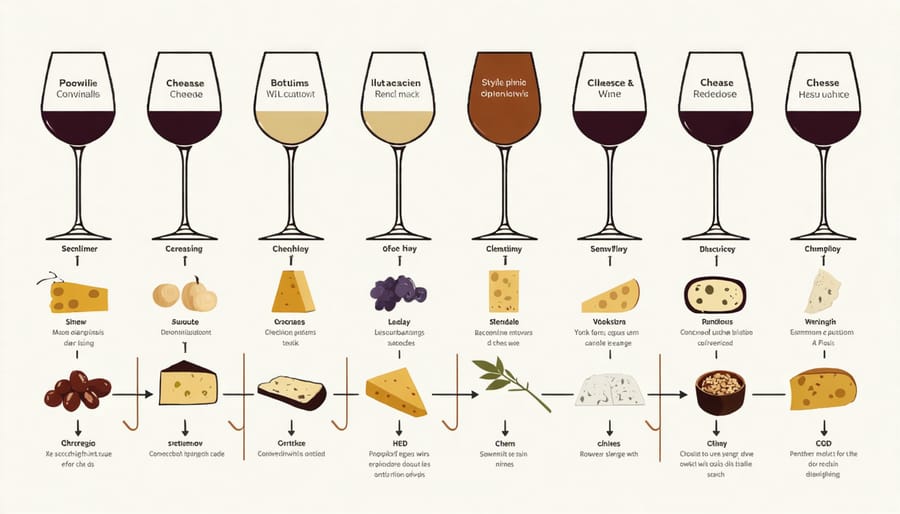
Wine Serving Tips and Techniques
Let’s talk about serving wine like a pro – it’s simpler than you might think! I remember being intimidated by all the “rules” at first, but trust me, once you know the basics, it becomes second nature. The key is to start with lighter wines and work your way up to fuller-bodied ones, just like how we build flavors in cooking.
Begin with sparkling wines or light whites, which wake up your taste buds without overwhelming them. These lighter options prepare your palate for what’s ahead and create some truly elegant wine pairing combinations. From there, move to fuller-bodied whites, then reds, and finish with dessert wines if you’re including them.
Temperature matters more than you might realize! Serve your whites and sparkling wines chilled (about 45-50°F), but not ice-cold – too much chill masks the delicate flavors. Red wines show their best at cool room temperature (60-65°F). Pro tip: take whites out of the fridge 15 minutes before serving, and pop reds in for 15 minutes before pouring.
Pour about 2-3 ounces for tasting portions – this gives everyone enough to experience the wine fully while keeping palates fresh. Having water and plain crackers available between tastings helps cleanse the palate and keeps everyone hydrated.
Hosting Tips and Interactive Elements
Tasting Games and Activities
Make your cheese and wine tasting class interactive and memorable with these engaging activities! Start with the classic “Blind Tasting Challenge” – wrap wine bottles in foil and number them, then let guests guess the varietals. It’s amazing how removing visual cues can sharpen your tasting skills!
Create a “Perfect Pair Match-Up” where participants receive cards with cheese descriptions and wine characteristics, then work together to find their ideal matches. This sparks great conversations and helps everyone understand pairing principles hands-on.
Try the “Flavor Profile Bingo” game – hand out cards with common wine and cheese tasting notes like “nutty,” “fruity,” or “earthy.” As guests taste each pairing, they mark off the flavors they detect. First to complete a row wins!
For a creative twist, set up a “Build Your Best Bite” station. Provide various accompaniments like honey, nuts, and fruits, challenging guests to create their ultimate cheese and wine combination. This activity encourages experimentation and shows how additional elements can enhance pairings.
Remember to keep score sheets for friendly competition, but focus on fun over perfection. These games help break the ice and make learning deliciously entertaining!
Discussion Points and Learning Moments
Encourage guests to share their tasting experiences and initial reactions – there’s no wrong answer when it comes to personal preferences! Guide the conversation by asking what flavors they detect, which combinations they enjoy most, and why certain pairings work better than others. This creates an interactive learning environment where everyone feels comfortable participating.
Keep a few discussion starters handy, like “What memories does this cheese remind you of?” or “How does this wine change when paired with different cheeses?” These questions help guests engage more deeply with the tasting experience and often lead to fascinating conversations about food traditions and travel stories.
Make note of surprising discoveries – perhaps a bold red wine that unexpectedly complements a delicate cheese, or how temperature affects taste. Share basic wine tasting techniques like swirling and sniffing, but keep it fun and approachable rather than overly technical. Remember, the goal is to help everyone discover new favorites while building confidence in their palate.
Consider keeping small notecards available for guests to jot down their preferred pairings for future reference.
Hosting your own cheese and wine pairing class is more than just an entertaining evening – it’s an opportunity to create lasting memories and deepen your appreciation for these timeless delicacies. Remember, the key to success lies in preparation and keeping things relaxed and enjoyable. Start small with 4-5 carefully chosen pairings, and don’t feel pressured to be an expert right away.
I’ve found that some of the most memorable pairing classes happen when hosts encourage their guests to trust their palates and share their impressions openly. There’s no wrong answer when it comes to taste preferences! Keep a journal of which combinations worked best, and don’t be afraid to experiment with new pairings in future gatherings.
Consider making it a monthly tradition with friends, where everyone contributes a different cheese or wine each time. This not only shares the cost but also adds an element of surprise and discovery to each session. You might even start a group chat to share findings and recommendations between gatherings.
Most importantly, remember that hosting a cheese and wine pairing class is about bringing people together to explore, learn, and have fun. With the guidelines we’ve shared throughout this article, you’re well-equipped to create an enriching experience that your guests will talk about for months to come. So go ahead – send those invites, prepare your tasting notes, and get ready to embark on your own culinary adventure!


